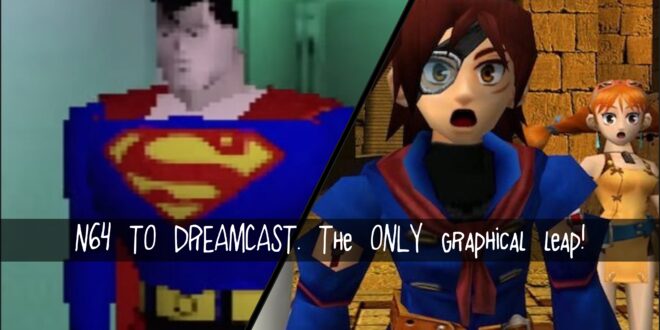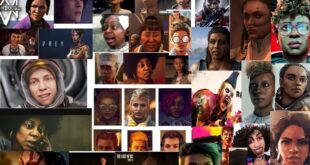The Game-Changing Graphical Ascendancy: Why N64 to Dreamcast Was the Real Revolution
Fact Piece (this is a fact)
As gaming aficionados wax poetic about the visual leaps from the PlayStation 2 to the PlayStation 3, they seem to have overlooked the true graphical deity of its time—the Sega Dreamcast. While the PS2 to PS3 evolution indeed brought us into the HD era, it pales in comparison to the seismic shift that occurred when we moved from the Nintendo 64 to the Dreamcast. This is the hill I choose to die on, and here’s why.
The N64’s Blurry Vistas versus Dreamcast’s Crisp Realities
Let’s set the scene: It’s the late ’90s, and the N64 is the pinnacle of console gaming with its groundbreaking move to 3D. But let’s be honest, those textures were as muddy as a rain-soaked field, and the polygons could sometimes feel like a cubist’s rendition of what a face should look like.
Then, like a bolt from the blue, came the Sega Dreamcast in 1998, and oh boy, did it bring clarity to our lives. The Dreamcast didn’t just improve upon the N64’s graphics; it catapulted us into a new dimension where characters had fingers instead of mitten hands, and environments had depth and detail rather than looking like a child’s cardboard diorama project.
Enter the Sega Dreamcast in 1998. Sega’s last console leapfrogged over the N64’s graphical prowess with astonishing advancements. The Dreamcast was the first home console to feature a built-in modem for internet support and to bring arcade-quality graphics to the living room. It marked the onset of the sixth generation of video game consoles and set new benchmarks with its 128-bit graphics engine.
The Dreamcast’s visual capabilities were a game-changer—literally. It could output in 480p, effectively doubling the resolution of most N64 games and delivering a crisper, more immersive gaming experience. Games like “Sonic Adventure” and “Soulcalibur” showcased this leap with their detailed textures, dynamic lighting, and fluid animations, offering a level of realism that seemed light-years ahead of the blocky, texture-warped worlds of the N64.
Dreamcast: The Unsung Hero of Its Time
The Dreamcast was a god among mortals, and yet, its name seldom comes up in the “greatest leap” conversations. It’s almost criminal. This console brought us visuals that we thought were decades away. Remember the first time you saw “Soulcalibur” on the Dreamcast? It was like someone had taken the arcade machine and somehow infused it into this little white box of wonder. It was not just Soulcalibur, but dozens of games at launch. Anyone who had this system in 1998 or 99, will forever remember this.
And it wasn’t just the graphics that were superior; the Dreamcast was the first to embrace online gaming, setting the stage for the connected play that is a staple today. It was ahead of its time, and perhaps that was its downfall. The world simply wasn’t ready for such a prodigious leap.
PS2 to PS3? Please, Spare Me the Drama
Sure, the PS2 to PS3 transition brought us into the age of HD, but let’s not get too carried away. It was an expected step, a linear progression. The Dreamcast leap, however, was a revolution. It was a beacon of what was possible, and it shook the gaming world to its core.
The Dreamcast’s graphics were so ahead of their time that, for a brief moment, it felt like Sega had discovered time travel. It wasn’t just a visual upgrade; it was a rewriting of the gaming language. The Dreamcast didn’t get its due because it was the Icarus of consoles, flying too close to the sun with its dazzling graphics and trailblazing features.
In Conclusion: Pay Homage to the True Champion
The graphical leap from the N64 to the Dreamcast is the stuff of legends. It was a transformative period that redefined what we expected from our consoles and our games. So, while modern gamers get lost in the details of their 4K textures and ray tracing, let’s pour one out for the real MVP of graphical leaps.
Although the Sega Dreamcast’s life was cut short due to various market factors, its impact on gaming graphics is indelible. From the jagged edges and blurry textures of the N64 to the sleek lines and detailed worlds of the Dreamcast, the leap in graphical quality was not just a step but a giant leap for the industry. In looking back, it’s clear that this era was a defining moment that would set the tone for the immersive, high-fidelity experiences that gamers now enjoy as a matter of course.
The N64 to Dreamcast transition remains a testament to the rapid advancements in technology and a nostalgic reminder of the excitement that each new leap in graphics brought to gamers around the world.
To the Dreamcast, the god of its era, we remember you. Your graphical prowess set a standard that we’re still chasing today. And to those who fixate on the PS2 to PS3, I say, “Booo.” You’ve missed the forest for the trees, my friends. The Dreamcast was, and always will be, the true graphical leap we didn’t deserve but were blessed to receive.
Everything said here is NOT opinion, but rather… fact.
 Retro-Replay.com Retro gaming reviews, news, emulation, geek stuff and more!
Retro-Replay.com Retro gaming reviews, news, emulation, geek stuff and more!





BOOOOOOOOOOOOOOOO